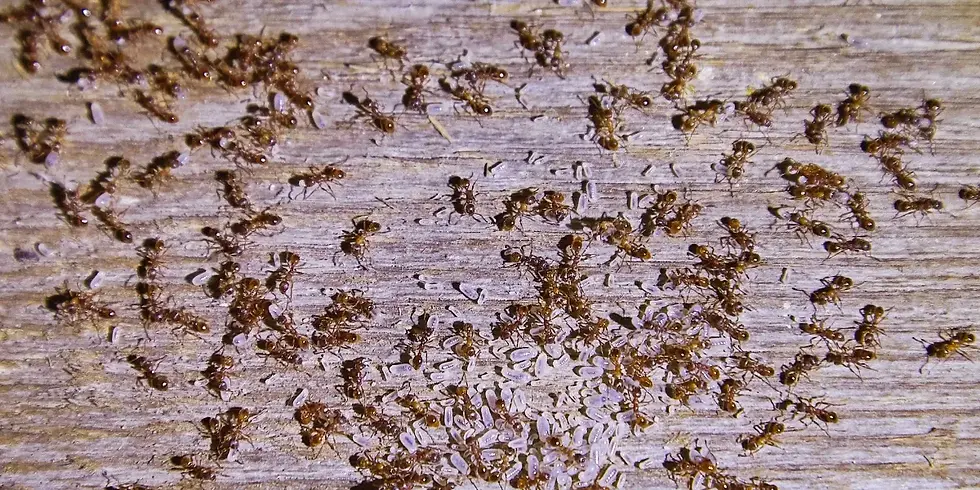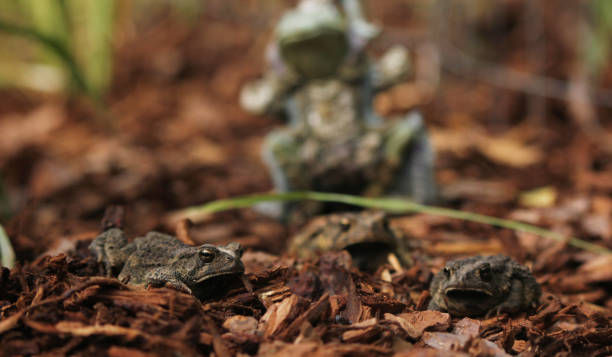Florida Carpenter Ants: Homeowner Guide | Port St. Lucie, Delray Beach
- Adam Allen

- Oct 27, 2023
- 7 min read
Updated: Nov 28, 2023

In the sunny expanse of Florida another resident thrives beneath the surface—Florida carpenter ants. These industrious insects have carved a niche for themselves, quite literally, in the Sunshine State. While they might not be as renowned as termites, these tenacious ants can cause their fair share of trouble when they decide to move in.
This comprehensive guide shines a light on the world of carpenter ants, revealing their distinctive appearance, nesting habits, dietary preferences, and more. Get ready to arm yourself with knowledge as we explore how to protect your home from these stealthy invaders!
Key Takeaways
Learn about the behavior and nesting habits of Florida carpenter ants, common indoor pests in South Florida.
Discover how to identify carpenter ant infestations through visible cues like dead ants and very loosely defined trails.
For effective carpenter ant prevention, professional pest control services are a must for direct treatment that's reliable and comprehensive.
The Florida Carpenter Ant: Appearance, Habitat, and Behavior

The Florida carpenter ant is robust and sizable insect. They might not be the most common indoor pests, but the carpenter ant species is notorious for its destructive potential and is not to be underestimated.
In this section, we'll take a closer look at this stealthy invader because understanding it is your first line of defense in safeguarding your home from its costly and disruptive presence.
Appearance
Florida carpenter ants, known scientifically as Camponotus floridanus, are robust and sizable insects. They come in various colors, including reddish-brown, black, or a combination of these hues.
These ants are among the largest ant species found in North America, with some reaching up to half an inch in length. Their distinctive feature is their smoothly rounded thorax and a single, prominent node on their abdomen.
Habitat and nesting sites

Florida carpenter ants nest in wood, which is how they got their name. Unlike termites, they don't consume the wood structures they inhabit but instead excavate it to create galleries and tunnels. The nest sites can be found in various wooden structures, such as tree stumps, logs, wooden fences, and even your home's framework.
Southeast Florida's warm and humid climate provides the ideal environment for these ants to thrive.
Reproduction lifecycle
Carpenter ants have a fascinating reproductive lifecycle. Colonies consist of wingless female worker ants, a winged queen, and sometimes winged males. In spring, winged ants embark on nuptial flights. After mating, the winged females shed their wings and become queens, each one establishing a new colony. This lifecycle perpetuates the ant population in your vicinity.
People sometimes mistake winged ants for winged termites because both have similar-looking reproductive forms with wings. However, there are distinguishing characteristics that can help tell them apart:
Winged ants typically have elbowed antennae, a constricted waist, and two pairs of wings that are different in size. In contrast, winged termites have straight antennae, a thick waist, and two pairs of wings of equal size.
Diet
Carpenter ants exhibit a diverse diet. While they don't consume wood, they primarily feed on sugars, proteins, and other insects. Their natural diet includes honeydew produced by aphids, plant juices, and dead insects. However, when they infiltrate your home, they're drawn to sugary substances like spilled drinks, open food containers, or pet food.
How Can You Tell If You Have Carpenter Ants?

Identifying a potential carpenter ant infestation in your Southeast Florida home requires a keen eye for subtle yet telling signs. While these pests often operate under the radar, early detection can make a significant difference in preventing structural damage.
Here are some key indicators to help you determine if you have carpenter ants on your property:
Wood shavings
Keep an eye out for small piles of wood shavings that resemble sawdust. Carpenter ants excavate wood to create galleries and tunnels for their nests, resulting in the expulsion of these tiny wood particles.
Audible noises
In some cases, homeowners have reported hearing faint rustling or crackling sounds emanating from within walls or wooden structures. While not always present, these noises can be a subtle clue.
Visible ants
Spotting large ants, often black or reddish-brown, can be a clear indication of a carpenter ant infestation. These ants are typically more active during the evening hours, and their presence should not be underestimated.
If you observe any of these signs around your property or inside your home, it's essential to take action promptly. Carpenter ants can compromise the structural integrity of your residence if left unchecked.
What Attracts Carpenter Ants to a Home?

Carpenter ants are drawn to several factors in and around homes. Understanding these attractants is the first step in effective prevention. Here are some key culprits:
Moisture and food sources
Carpenter ants have a preference for damp or water-damaged wood. If your home has areas with moisture issues, such as leaky pipes, poorly sealed windows, or roof leaks, it creates the ideal conditions for carpenter ant nesting.
And like any living creatures, carpenter ants need sustenance. They aren't finicky eaters and will eat generally any type of food you leave out, such as open food containers, crumbs, and unsealed pet food. These can be enticing food sources that lure ants into your living spaces.
Wood sources
Carpenter ants are notorious for nesting in wood. This includes untreated wood, tree holes in tree trunks, firewood stacks, rotting wood, old tree stumps, and even wooden structures near your home. And if you have old wood furniture you've dumped anywhere inside your property, that too can serve as a nest area for the carpenter ant species.
Do you have tall trees touching structures on your property? Those tree branches can serve as convenient pathways for ants as these provide foraging access to your home.
Cracks and openings

Gaps, cracks, and wall voids in your home's structure, such as wood panels and window and door frames, can offer convenient entry points for carpenter ants. These insects are adept at finding vulnerabilities and exploiting them.
Tips for Keeping Carpenter Ant Nests Away
To effectively prevent carpenter ant infestations and safeguard your home, it's essential to adopt proactive measures that create an unwelcoming environment for these wood-damaging insects.
Here are key tips for carpenter ant prevention:
Caulk cracks and openings

Seal any cracks, openings, and existing voids from your window ledges to your door frames and all around the exterior of your home. Carpenter ants are skilled at finding tiny entry points, so thorough caulking is crucial to keep them out.
Remove old tree stumps
Eliminate old tree stumps and keep vegetation trimmed within a two-foot radius of your property. Carpenter ants often nest in decaying wood sources like stumps, so removing these potential nesting sites is a preventive step.
Secure food storage

Store your food in airtight jars and containers. This not only prevents ants from accessing your pantry but also deters other pests. Make sure to address any food spills promptly to reduce the allure of your home.
Maintain cleanliness
Keep your property clean and free from food spills and crumbs. Regular cleaning routines can significantly reduce the chances of attracting carpenter ants and other pests.
Professional pest control

Consider scheduling regular inspections and seeking services from a trusted pest control professional (that's us!). Southeast Florida Pest Control's expertise can help you identify early signs of carpenter ant activity and implement effective preventive and control measures. We serve many areas in South Florida, including Delray Beach and Port St. Lucie.
We understand the importance of safeguarding your home and loved ones from potential pest threats. And as you've learned from this guide, Florida carpenter ants can pose a significant risk to your property. Our objective is to prevent that from occurring.
Our expert team offers annual inspections and custom services tailored to the unique needs of our communities. We'll help you identify and address carpenter ant infestations promptly, ensuring a swift and effective response to protect your home.
Defend Your Home: Carpenter Ant Prevention Starts Here
When it comes to protecting your home from the stealthy invaders known as carpenter ants, you need a proactive defense plan. Don't let these wood-destroying pests compromise your sanctuary. Explore our expert tips and take action today to keep your home safe and carpenter ant-free.
Remember, prevention is the key to preserving your home's structural integrity. From caulking cracks to securing your food supply, you can make your home an unwelcome environment for carpenter ants. But if you ever suspect an infestation, our professional pest control services are just a call away, and we don't rely on toxic baits.
Choose the path of effective prevention with Southeast Florida Pest Control! Contact us now at 855-505-0702!
Summary
In conclusion, this article has shed light on the behavior and nesting habits of Florida carpenter ants, which are common indoor pests in South Florida. By learning how to identify carpenter ant infestations through visible cues like dead ants and very loosely defined trails, you can take proactive steps to protect your home.
However, when it comes to ensuring effective carpenter ant prevention and treatment, it's essential to recognize the value of professional pest control services. These experts offer direct treatment that's not only reliable but also comprehensive, giving you the peace of mind that your home is free from the unwelcome presence of carpenter ants.
Don't hesitate to reach out to trusted pest control professionals to safeguard your home and enjoy a pest-free living environment.
Frequently Asked Questions
Are Florida carpenter ants harmful?
Yes, Florida carpenter ants can be harmful. While they don't consume wood like termites, they excavate it to create nests, potentially causing structural damage to wooden structures. Early detection and prevention are essential to mitigate their impact.
What kills Florida carpenter ants?
If you want to eliminate Florida carpenter ants that have made their home on your property, only professional pest control services can do it. DIY methods are not reliable, and the ants will probably just come back and establish new nests.
Look for pest control companies that use safe and scientifically proven techniques, such as Southeast Florida Pest Control. We offer expert pest management without relying on toxic baits, ensuring the safety of your home and the environment. Call us at 561-488-1104 to know more.
Are carpenter ants native to Florida?
Yes, carpenter ants are native to Florida. Florida carpenter ants (Camponotus floridanus) are a species of carpenter ants found in the state. They have adapted to the warm and humid climate of Florida.
What do Florida carpenter ants eat?
Florida carpenter ants have a diverse diet. They primarily feed on sugars, proteins, and other insects. Their natural diet includes honeydew produced by aphids, plant juices, and dead insects. When they invade homes, they are attracted to sugary substances like spilled drinks, open food containers, or pet food.



